Selecting the best dog food to feed your dog – and how much and how often - is one of the first decisions you’ll have to make as a pooch parent. And it is an important one, as they’ll need the right diet to thrive. But with so many offerings on the dog food market, it can be difficult to know where to start.
Add into the mix that the nutritional demands of your dog will also be impacted by factors such as their breed, weight, activity levels, age and health, and the process can seem overwhelming.
But fear not, because with the help of Vanessa Howie, head veterinary surgeon of companion animals at the RSPCA, our dog food feeding guide below will tell you everything you need to know to ensure you give your pup the grub that is right for them.
What diet should you feed your dog?
A good place to start is by discussing the nutritional needs of your dog with your vet. They will take into account their age, breed, activity levels, medical issues and allergies and also be able to advise on alterations to make as your pooch ages and if their health changes.
But generally, a ‘complete’ (see Vanessa’s FAQs below) dog food should provide your pooch with everything they need (usually a mix of meat, vegetables, grains, and fruits) – and most are now available to suit their different life stages: puppy, adult and food for senior dogs. As your pooch ages, remember to transition them to different foods gradually.
Once you know the nutritional needs of your four-legged friend, you may well find that there is a range of both wet and dry food suitable for your pooch.
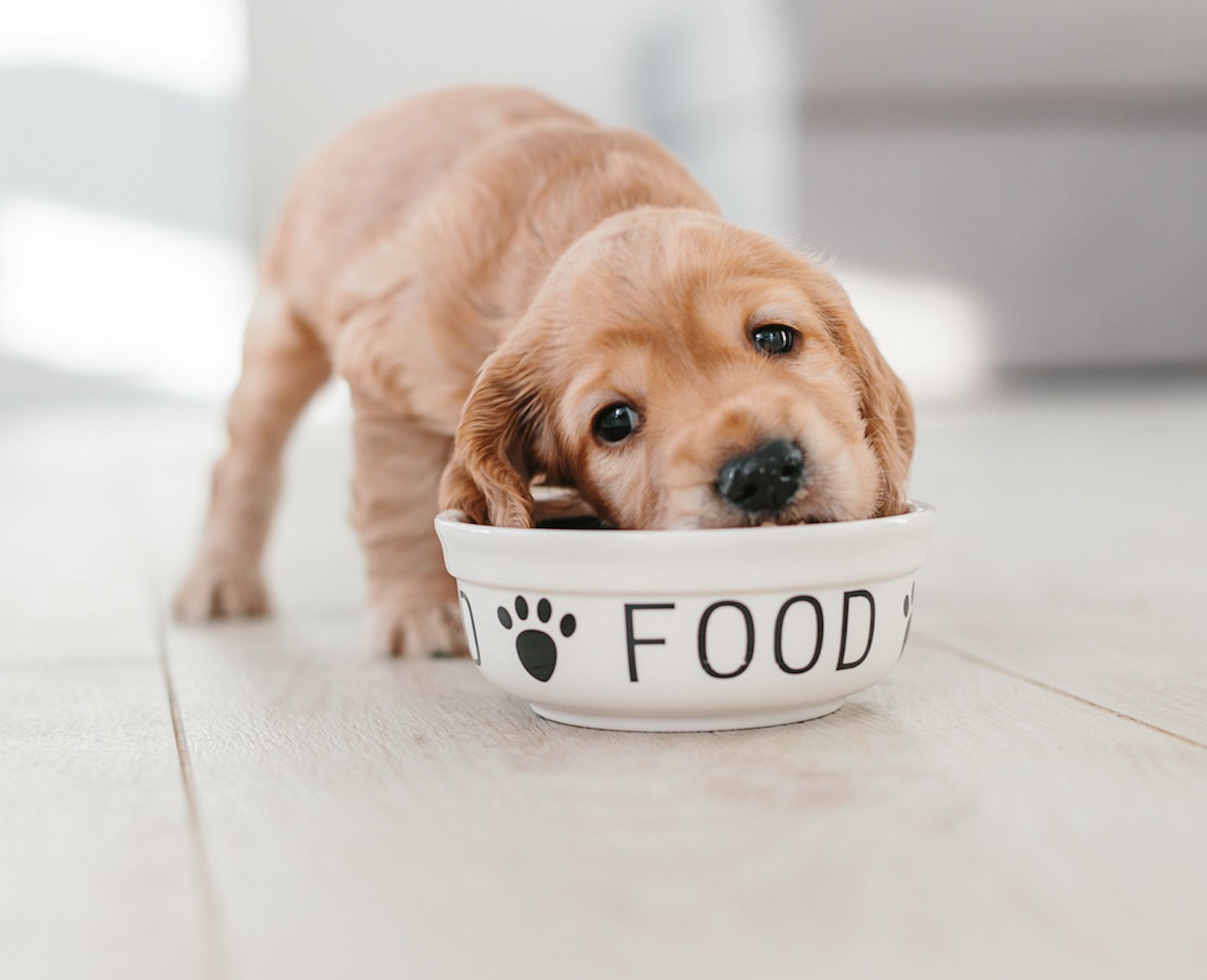
Should you feed your dog wet or dry food?
Wet food – The pros of wet dog food are it contains water, giving your dog extra hydration. It can also be easier for dogs with dental or mouth issues to eat wet food, as it is generally softer than kibble. It also smells stronger, which is more appealing to dogs – especially if they are poorly.
The cons are that wet food doesn’t last as long (making it less economical), is more pungent to humans and can cause dental problems (as it tends to stick in your dog’s mouth longer).
Dry food – The pros of dry dog food is that it is more cost-effective, stores more easily, and doesn’t spoil as quickly (meaning you can leave it out over a day). Dry food is better for your dog’s dental health too. It also comes in breed-specific sizes (for examplekibble for small dogs), meaning the kibble won’t be too big or small for your pooch’s mouth.
The cons are that it doesn’t have as much moisture as wet food – which can be a problem when the weather is very hot, or for older or animals who are unwell. It also doesn’t smell as strongly, meaning it can be less enticing for some four-legged friends.
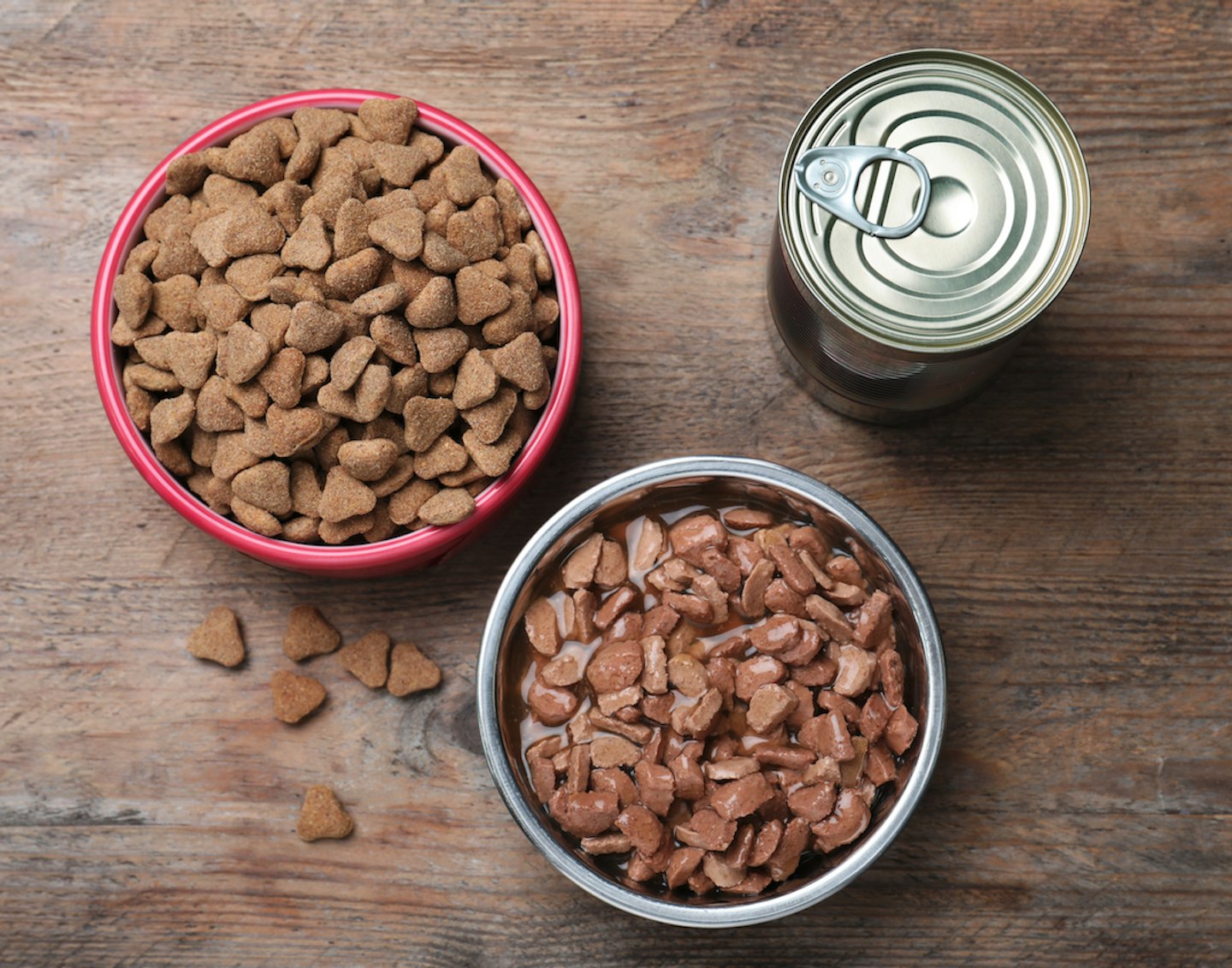
Home-cooked and raw diets
Most vets recommend feeding dogs a good, nutritionally balanced, complete commercial dog food (either in a prepared wet or dry form). Having said that, home-cooked and raw diets have been growing in popularity in recent years. While both have strong supporters, they do pose more potential problems than traditional ‘complete’ options.
It is possible for a dog to thrive on a home-cooked diet, but keep in mind that it is a big commitment to prepare their food in this way. And it is vital to thoroughly research what you’re preparing is providing your four-legged friend with all the nutrients they need.
It is not recommended to feed a home-cooked diet to puppies (puppyhood can last until 18 months of age), as they are very sensitive to nutritional imbalances - opt for a puppy food instead.
Raw dog food or diets are made up of primarily raw meat and bones. While this means your dog will get a lot of protein, they may miss out on other essential nutrients, which could result in a deficiency.
Handling raw meat can also cause the spread of harmful bacteria, which can be dangerous to you, others in your household and your dog – so if you’re preparing the food yourself, make sure to maintain thorough hygiene practices. There are pre-prepared raw foods available – that often come frozen – which reduce this risk.
You should also keep in mind that bones can also be harmful to your pup too, as there is a risk of them getting stuck or even puncturing their stomach.
Before feeding your dog either a home-cooked or raw diet, speak it through with your vet first.

How much should you feed your dog?
Dishing up the correct amount of food is just as important as feeding your pup the right food.
RSPCA vet Vanessa Howie says: "Always read the feeding guidelines for the prepared food you’ve chosen. Feeding guidelines can vary between food products but the amount to feed should be clearly outlined on the packaging. If you’re unsure about how much to feed your dog, ask your vet for advice."
Once your four-legged friend is settled on a food, keep an eye on their weight as this is the easiest way of telling whether the servings are the right size.
Compare your dog's body shape to the image below. Your dog is at their ideal weight when you can feel, but not easily see, the last two or three ribs and when there is an identifiable waistline when looking down from above.
If your dog is gaining excessive weight, or losing weight (and health issues have been ruled out), adjust the amount you are feeding them until they reach their ideal weight. If you need help with this, you can find dog food ideal for weight loss that's packed with nutrients but with lower calories. Or, if your pooch needs more calories, try a dog food for weight gain instead.
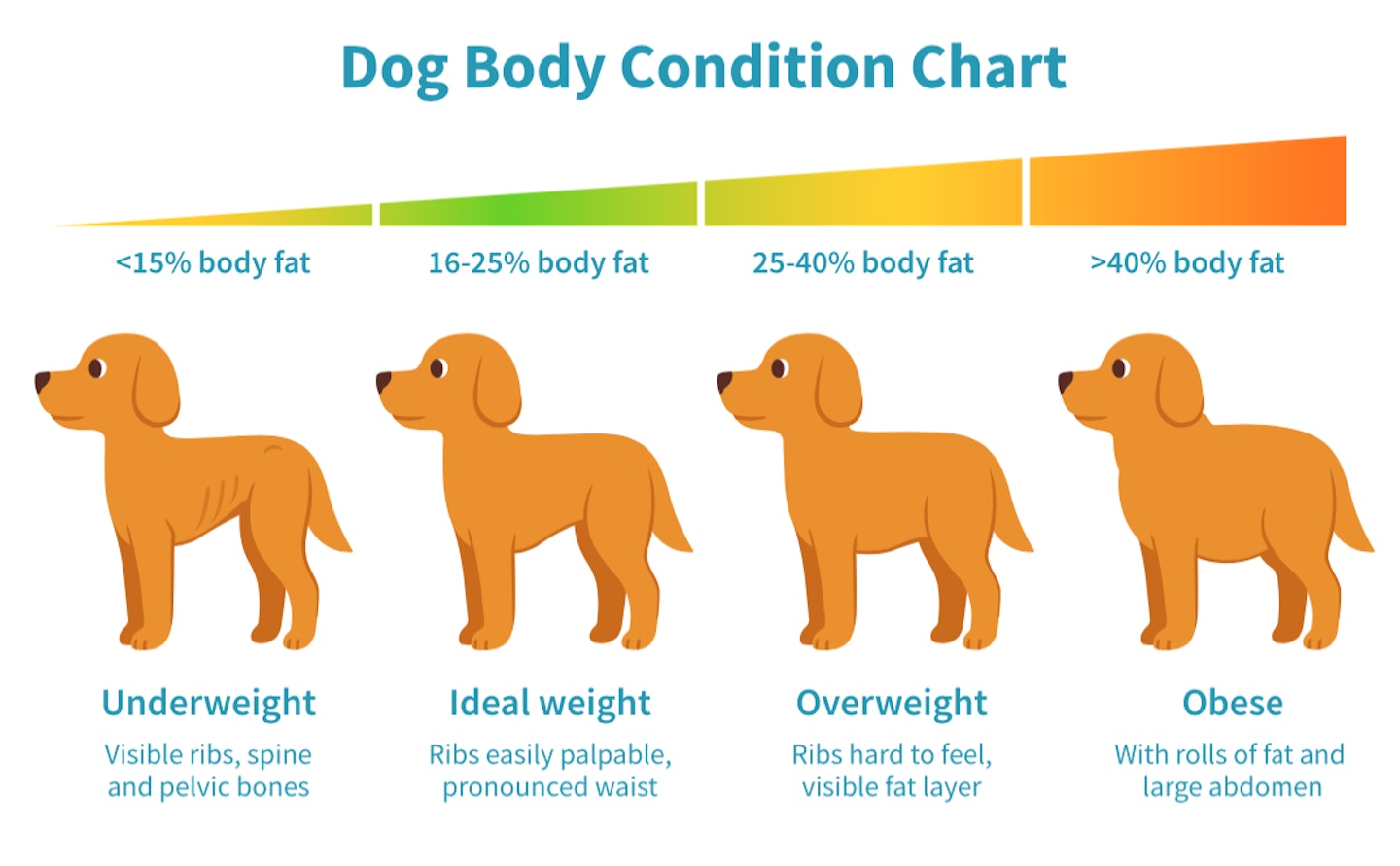
Below, Vanessa Howie, head veterinary surgeon of companion animals at the RSPCA, answers your frequently asked questions about dogs going off their food.
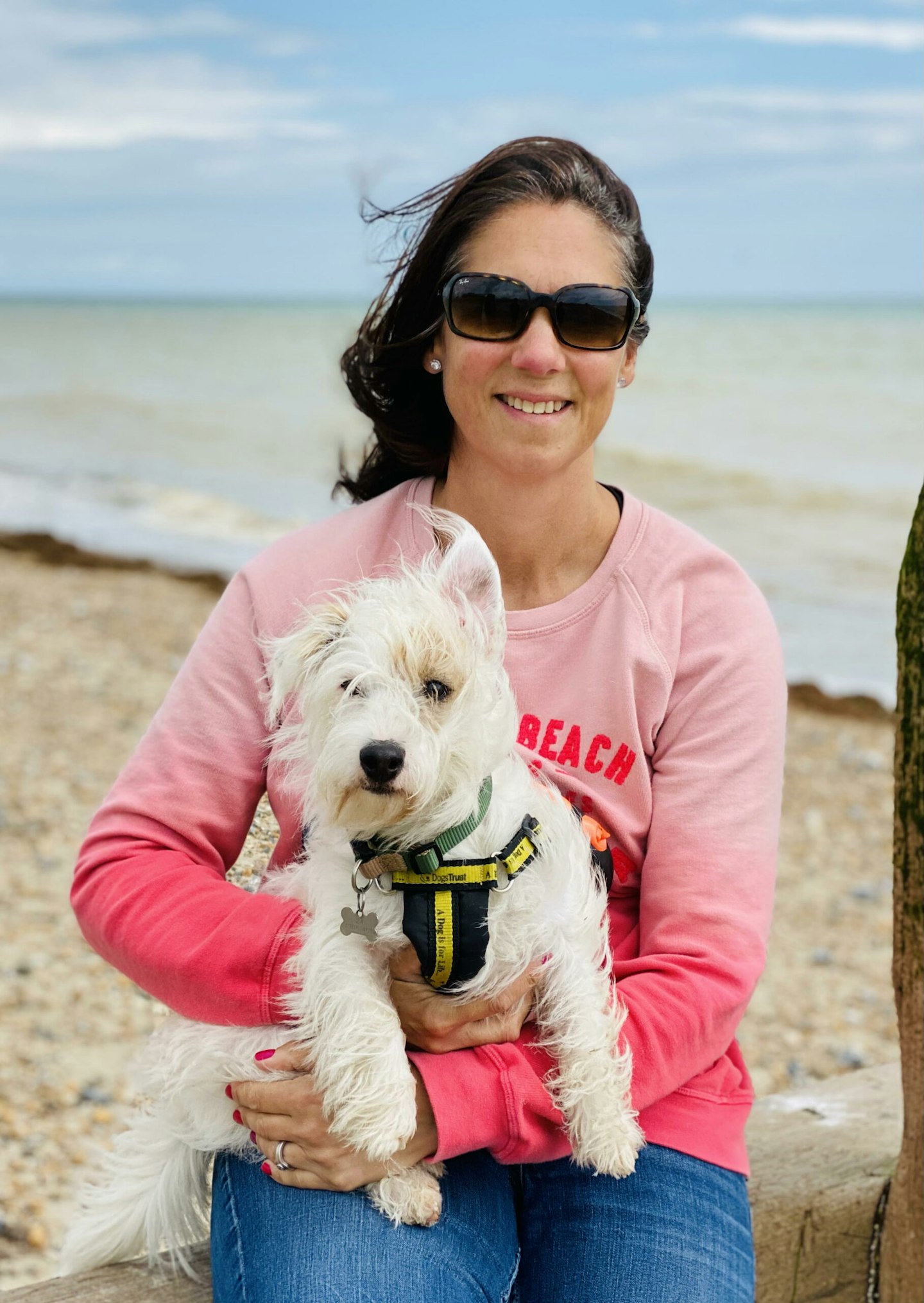
Dog food feeding guide FAQs
What factors could impact how much I feed my dog?
You should always feed a diet suitable for your dog’s age and lifestyle, and one that matches their health needs. A dog’s nutritional needs may change depending on their age and activity levels. All of these factors may affect the type of food you feed as well as the amount.
The type of food you feed your dog, such as wet versus dry food or the dog food brands you choose will also affect the quantity you feed.
Feeding your dog the right type and amount of food is crucial to their wellbeing.
How often should I feed my dog?
Unless advised otherwise by your vet, feed your dog at least once a day.
Some dogs may prefer to be fed more often but be careful not to overfeed if feeding more than one meal - ensure you divide up your dog’s daily food allowance over the meals if this is the case.
The feeding guidelines on the food product you’ve chosen should tell you how much and at what intervals to feed your dog.
Why is feeding my dog the right amount of food important?
It’s important to give your dog the right amount of food to make sure they don’t become under- or overweight.
The amount of food your dog needs depends on their diet, age, lifestyle and health.
If you’re concerned that your dog is under- or overweight it’s always best to speak to your vet. They can examine your dog to check both their body condition score and their weight, recommend what these should be, and offer advice on feeding.
There are a few simple regular checks you can make to check your dog’s body condition and help prevent them from becoming overweight:
• Make sure you can see and feel the outline of your dog’s ribs without excess fat covering.
• You should be able to see and feel your dog’s waist and it should be clearly visible when viewed from above.
• Your dog’s belly should be tucked up when viewed from the side.
If your dog doesn’t pass all three checks, or if you are in any doubt about their weight, always talk to your vet. For further information visit RSPCA.
What is complete dog food?
A complete dog food provides all of the 37 essential nutrients a dog needs in the right amounts and proportions.
By feeding a prepared complete dog food you can ensure you are feeding your dog a well-balanced diet to meet the needs of your dog.
Do you have a dog food brand you recommend?
It’s important to always feed your dog a nutritionally balanced, complete dog food. I would recommend a prepared diet from a manufacturer who is a member of UK Pet Food.
Your vet will be able to offer you advice on the best food for your dog based on their age, lifestyle and health.
What are the most important nutrients for dogs?
There are 37 essential nutrients that your dog must obtain from their food. Each of these nutrients is important to help keep your dog happy and healthy.
Always make sure your dog has access to plenty of clean, fresh drinking water as well.
What should I do if my dog isn’t eating?
There are many reasons why your dog may not be eating their food. Some dogs are naturally fussy eaters and a change in diet may stop them from eating. It’s important to rule out illness or tooth issues as the cause, so get your dog checked over by your vet first.
If illness and tooth issues have been ruled out and your dog is still not eating there are a number of things you can try to encourage them to eat (but I recommend always speaking to your vet first before making any changes to your dog’s food) which include:
Warming their food or adding warm water to their kibble may make it more appealing and encourage them to eat.
Changing their food - for example from dry kibble to meat or adding a small amount of something more tasty mixed in with their food such as boiled chicken may help.
Changing how, when and where you feed your dog, such as changing the type of plate or bowl or where you place the bowl may help, particularly if a negative experience has happened which has led to them not wanting to eat. This may also change whether you feed them near to or away from other animals, including humans.
Taking them for a walk before mealtimes but be careful not to give too many treats while out on the walk.
Cutting down on treats between meals or making feeding time more fun or stimulating by using a toy that dispenses food or rewarding them with food from their meal yourself - maybe train them to do another trick.
What should I do if my dog is eating too quickly?
Eating too quickly can be a sign of underlying illness, but other reasons such as competition from another dog or other animals in the household, feeding a low-quality food or irregular meal times may all contribute to a dog eating too fast.
It’s important that your dog receives a check-over from your vet if there has been a change in how quickly your dog eats their food. If illness isn’t the cause, to try and slow your dog’s eating down you can try some of these ideas:
Try feeding your dog somewhere private, away from other animals so the threat of another animal in the household eating their food is removed.
Ensure you are feeding a high-quality, complete dog food.
Keep mealtimes at the same time each day, so your dog isn’t worrying when their next meal is coming. You can also feed your dog smaller meals more frequently, for example, two or three times a day, so they’re not getting all their food at once.
Use a special slow feeder bowl that has inbuilt obstacles to make it harder for your dog to eat their food quickly.
Use a feeding ball or puzzle to make feeding time more fun and slow your dog down as they have to get the food out of the toy before they can eat it.
What should I do if my dog is always hungry?
Firstly, it’s important to rule out illness with a visit to your vet. Increased hunger may be the first sign of a health issue such as diabetes. Having worms can also cause your dog to become more hungry than usual. Ask your vet for advice on worming treatments, and regularly treat your dog for worms to prevent them from causing a problem.
If an illness has been ruled out, other reasons for always being hungry may include feeding your dog the wrong type or quantity of food, boredom and stress.
Make sure you are feeding your dog the correct amount of a nutritionally balanced, complete dog food suitable for your dog’s age, lifestyle and health.
Try to reduce your dog’s boredom and stress levels by providing ample opportunity for physical exercise and mental stimulation which will help to reduce your dog's reliance on snacks and that constant craving for food.
Spend more time with your dog interacting through play or training (why not teach your dog a new trick?) to help relieve stress and boredom.
Also consider using feeding puzzles and balls as a valuable interactive toy to help provide more mental stimulation for your dog as they have to ‘work’ for their food, helping them to feel more satisfied and less bored and hungry.
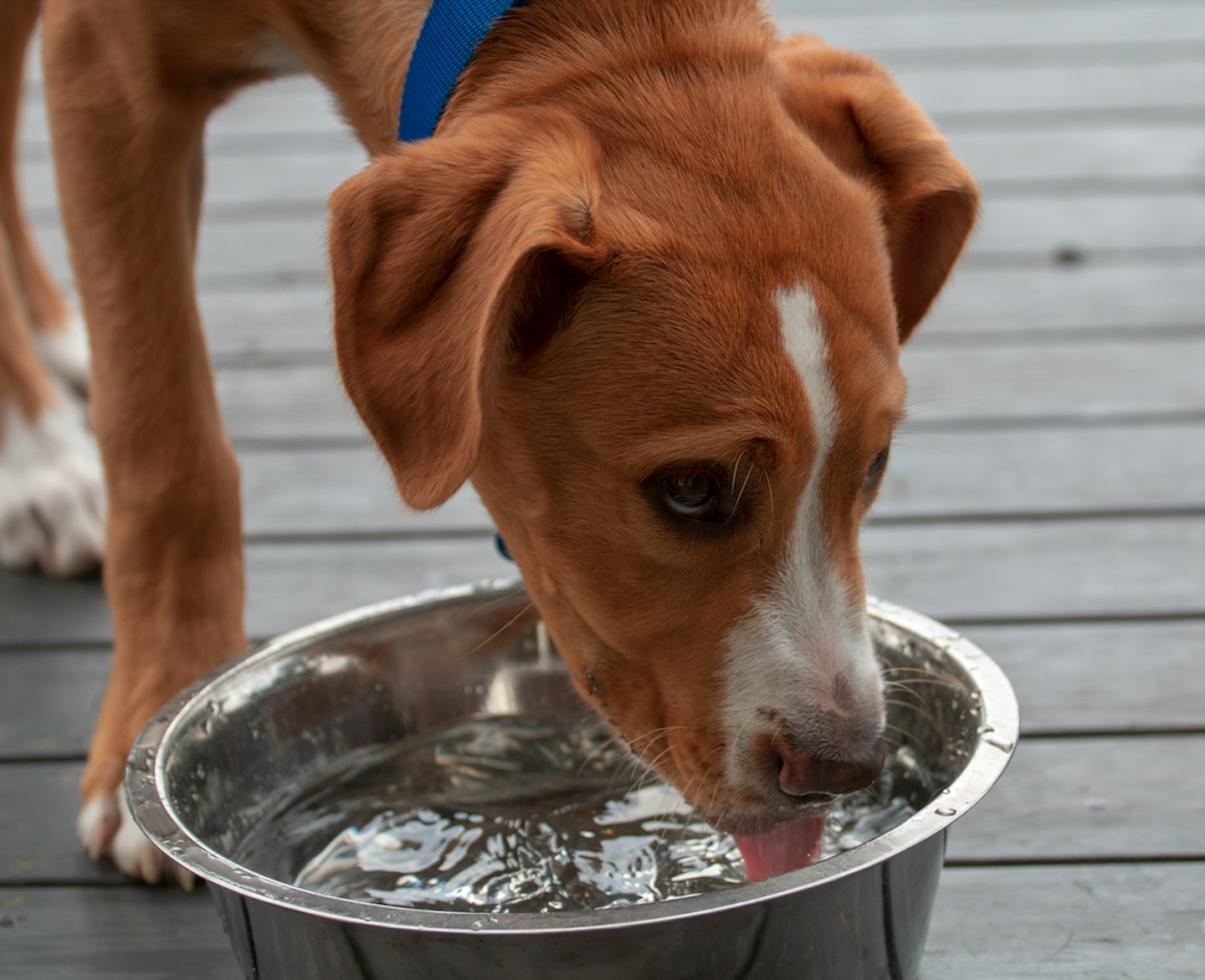
This article contains expert advice from Vanessa Howie, head veterinary surgeon of companion animals at the RSPCA.
Joe Brothwellis editor of Take a Break Pets and adores all creatures great and small. Despite being a doting cat dad to Winnie, she continues to be aloof!
